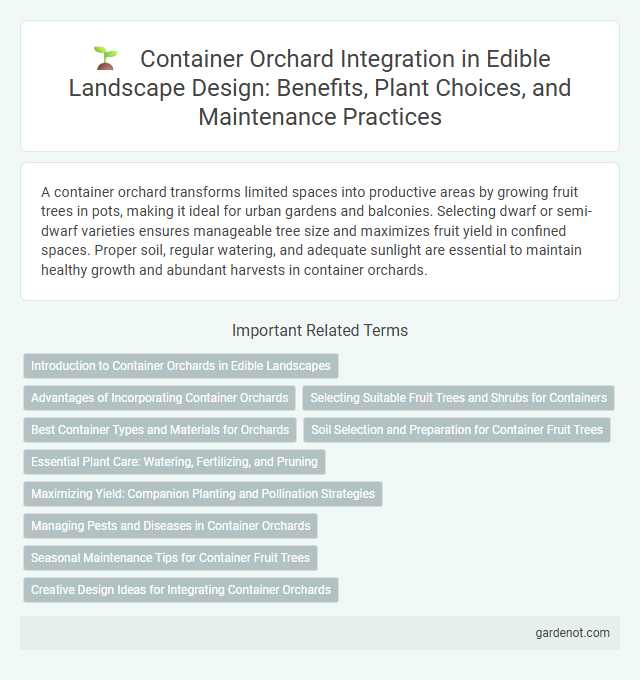A container orchard transforms limited spaces into productive areas by growing fruit trees in pots, making it ideal for urban gardens and balconies. Selecting dwarf or semi-dwarf varieties ensures manageable tree size and maximizes fruit yield in confined spaces. Proper soil, regular watering, and adequate sunlight are essential to maintain healthy growth and abundant harvests in container orchards.
Introduction to Container Orchards in Edible Landscapes
Container orchards offer a versatile solution for integrating fruit trees into edible landscapes, especially where space or soil quality limits traditional planting. Using large pots or containers, these orchards enable precise control over soil conditions, moisture, and nutrient availability, promoting healthy tree growth and fruit production. Ideal for patios, balconies, or urban gardens, container orchards make fruit cultivation accessible without requiring extensive yard space.
Advantages of Incorporating Container Orchards
Incorporating container orchards maximizes space efficiency, allowing fruit trees to thrive in limited or urban environments. These portable systems facilitate better pest management and soil control, promoting healthier tree growth and higher yields. Container orchards also enable seasonal flexibility and easier harvesting, enhancing overall productivity and sustainability.
Selecting Suitable Fruit Trees and Shrubs for Containers
Choosing suitable fruit trees and shrubs for container orchards involves prioritizing dwarf or semi-dwarf varieties such as dwarf apple, cherry, and citrus trees that adapt well to restricted root space. Consider rootstock compatibility, container size, and drainage to ensure healthy growth and fruit production. Opt for self-pollinating species or plant multiple compatible varieties to enhance pollination and maximize yield in limited spaces.
Best Container Types and Materials for Orchards
Choosing the best container types and materials for a container orchard involves prioritizing durability, drainage, and root space to ensure healthy fruit tree growth. High-quality containers made from materials such as terra cotta, resin, and wood offer excellent breathability and moisture retention, supporting optimal root health for species like dwarf apple, citrus, and fig trees. Self-watering containers and those with ample drainage holes reduce the risk of overwatering, promoting sustained growth and fruit production in compact edible landscapes.
Soil Selection and Preparation for Container Fruit Trees
Selecting well-draining, nutrient-rich potting soil with a balanced pH between 6.0 and 7.0 is essential for container orchard success. Incorporate organic matter like compost and aged manure to improve soil aeration and fertility, ensuring robust root development. Proper preparation includes sterilizing soil to prevent pathogens and adding slow-release fertilizers to support long-term fruit tree growth in confined spaces.
Essential Plant Care: Watering, Fertilizing, and Pruning
Container orchards require consistent watering to maintain moist but not waterlogged soil, ensuring healthy root development. Fertilizing with balanced, slow-release nutrients supports fruit production and overall plant vigor in limited soil environments. Regular pruning promotes airflow, removes dead branches, and shapes the tree for optimal sunlight exposure, enhancing fruit quality and yield.
Maximizing Yield: Companion Planting and Pollination Strategies
Container orchards maximize yield by integrating companion planting techniques that enhance pollinator attraction and pest control. Strategic placement of flowering herbs, such as lavender and marigold, improves beneficial insect visits and supports fruit set in confined spaces. Utilizing self-pollinating varieties alongside hand pollination methods further optimizes fruit production within compact container environments.
Managing Pests and Diseases in Container Orchards
Effective management of pests and diseases in container orchards involves regular monitoring for common issues such as aphids, scale insects, and fungal infections like powdery mildew. Employing organic treatments like neem oil and introducing beneficial insects such as ladybugs can reduce chemical use and promote a healthy ecosystem. Proper sanitation, adequate airflow, and maintaining balanced soil moisture are critical to preventing pathogen spread and ensuring robust fruit production in edible landscapes.
Seasonal Maintenance Tips for Container Fruit Trees
Container fruit trees require consistent seasonal maintenance to ensure healthy growth and fruitful yields. Pruning during late winter promotes airflow and removes dead branches, while regular watering and fertilization in spring and summer support vigorous development. Dormant oil sprays in fall help prevent pests and diseases, ensuring the trees remain robust through winter dormancy.
Creative Design Ideas for Integrating Container Orchards
Incorporating container orchards into urban spaces maximizes limited areas while providing fresh fruit harvests. Utilize tiered planters and vertical supports to optimize growth patterns and aesthetic appeal, blending functionality with creative greenery. Select dwarf or semi-dwarf fruit tree varieties for manageable size and high yield, ensuring vibrant seasonal color and continuous productivity in compact environments.
Container orchard Infographic

 gardenot.com
gardenot.com